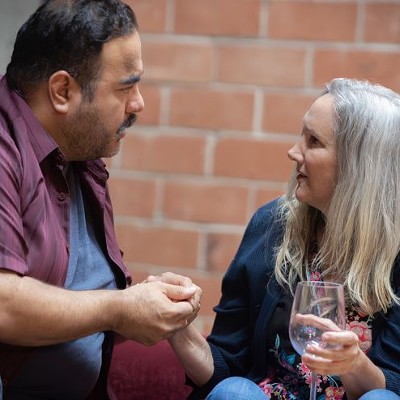When you think of Greenpeace, fashion may not be the first thing to come to mind. Climate change, Arctic drilling, and whaling are its most visible campaigns, but its Detox campaign is focused on exposing "links between textile manufacturing facilities causing toxic water pollution in China, and many of the world's top clothing brands."
Detox is relatively new, having launched in July 2011. Their campaign video, done in a quasi-anime style, opens with a classic movie trailer opening line voice-over:
"They lived in a world where image had become everything!"
The 90-second video goes on to illustrate how fashion manipulates us ("Purple is the new yellow! Fabulous!") into a constant stream of consumerism that ignores--or remains willfully ignorant of -- the environmental toll manufacturing these fashionable goods takes on the planet. The video's description reads, in part:
They say you can tell next season's hottest trend by looking at the colour of the rivers in Mexico and China. That's because global fashion brands like Calvin Klein, GAP and Victoria's Secret are using hazardous chemicals and dyes to make our clothes. These chemicals poison our rivers, and traces of these hazardous chemicals also end up remaining in many of the garments people buy.
So let's take a look at the Detox campaign, and what it means for us as consumers.
About the Detox Campaign
With its Detox Campaign, Greenpeace is asking global brands to commit to toxic-free production of their products; "fashion made without pollution." To date, eight international brands have signed on to the commitment: Adidas, C&A, H&M, M&S, Li-Ning, Puma, and Zara. These companies have promised to choose suppliers who use environmentally-friendly processes, as well as "providing greater transparency around the chemicals that their suppliers currently release into our shared waterways." With big brands exerting the pressure on smaller suppliers, the goal is to keep harmful chemicals out of waterways, as well as out of the final products which we, the consumers, eventually wear. Greenpeace is exerting pressure on Victoria's Secret, GAP, and Esprit to follow suit.
The Detox Solution
The detox solution asks companies to phase out use of toxic chemicals by January 1, 2020 and to follow three basic steps as part of that process:
1. Zero discharge of all hazardous chemicals in the manufacturing process. 2. Prevention and precaution, with a focus on eliminating toxic waste; exploring sustainable alternatives when possible and product redesign when it is not. 3. Right to know, with a fully transparent supply chain (through public disclosure about products and practices) to ensure accountability.
Detox Campaign for the Consumer
As a consumer, what part does Greenpeace want you to play in the Detox campaign? Well, there is the ubiquitous Greenpeace petition/pledge--the Detox Manifesto--for you to sign, indicating your commitment to three common detoxification beliefs:
1. The belief that brands/suppliers must act immediately to "stop poisoning waterways around the world with hazardous chemicals." 2. Suppliers must be transparent during the detoxification process ("we recognize that this will not happen over night"). 3. Rewarding and collaborating with "honest and progressive suppliers and brands" while encouraging others to follow suit.
Detoxification Détente: Cleaning Out Our Closets
Greenpeace offers a few commonsense ways for people (hashtag #PeoplePower) to work at the consumer level toward detoxification in fashion: Shop second-hand instead of new; "influence brands" and challenge them to make the right choices; "demand governments act" by restricting sales and import of products that contain hazardous chemicals.
The message is good, and the steps are actionable, if a bit vague. "Influence brands" leaves the door kind of wide open: Public shaming of GAP on Twitter? Body checking bra shoppers at Victoria's Secret? Stage an intervention for your friend who shops Esprit? Okay, so maybe that's a little snarky, but aside from not shopping somewhere, "influencing brands" is still a bit fuzzy. That said, it wouldn't hurt any of us to look more closely at the brands we shop, as well as their suppliers; calling for greater transparency is definitely a good thing.
And while it's great that a high-visibility name like Nike has pledged greater transparency in its use of manufacturing chemicals, we should remember that Nike also has a history of human rights abuses going back more than a decade. Nike continues to work to improve its record and its public image on the human rights front (the company celebrated Human Rights Day with a 10k in South America in March of 2012, for example), but groups like OxFam are still holding the company's running shoes to the fire, if you will, in countries like Indonesia and Vietnam.
It's interesting to see Greenpeace make its way into a topic that might have more resonance with people -- particularly Americans -- than something like the Arctic (where most people have never been, and probably won't visit) or whaling practices; we all shop for clothes at some point. If ubiquitous brands like H&M, Zara, and Nike are on board, it could be just the -- uh -- tip of the iceberg.





